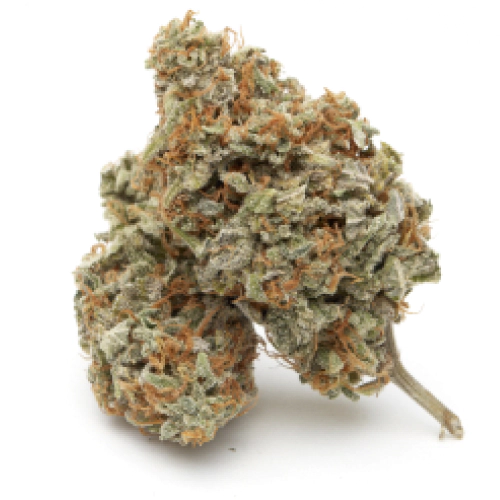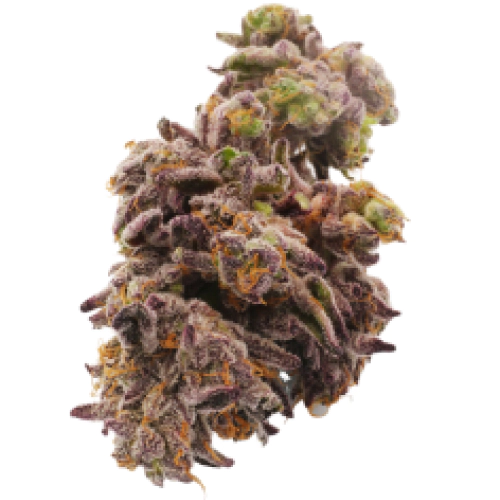THC 22 - 25%
CBD 0.14 - 0.41%
Effect Sedated
Flavor Apricot
18 - 19.5%
0.28 - 0.67%
0.2 - 0.6%
Sweet, Spicyherbal
Relaxed
Fruit Loops got its name for a reason. As a mixture of White Widow, Blue Dream, Grapefruit, and Blueberry, it tastes like delicious cereal. Parent strains, in turn, are viral, which adds to the prestige of Fruit Loops. This 50/50 hybrid has a potent high, so if you have a low tolerance or are a beginner, then be very careful. When breaking the buds, the user can immediately catch the strong smell of spices and apricot, obtained thanks to eucalyptol. Camphene adds a berry flavor, while myrcene makes the cannabis sweet.
Fruity Loops strain buds are rounded and dense. These are pieces of green with a yellow tint, covered with fiery red hairs and crystal trichomes. Tokers report that these buds produce a thick cloud when smoking. The harshness of smells can make you cough. Likewise the above aromas, you can experience:
The THC of this marijuana makes up 18-20% of the content. The high appears gradually. However, one or two puffs are enough for users to feel the effect soon. Consumers describe it as a relaxation of the body and a strong flow of thoughts. Tingling sensations accompany the whole buzz. That does not prevent the user from feeling very happy and motivated, though. Indica makes the body light, but later makes you lie down. Fruit Loop Haze strain pairs well with hanging out with friends. It loosens your tongue and lets you have plenty of fun and laugh with loved ones. Fruit Loops weed strain with this potency can deal with pain and migraines. It allows you to eliminate the stress and worries that hang over you temporarily. You will not even notice how your fatigue goes away. Another medical benefit of marijuana is its hypnotic effect, which helps relieve insomnia.
Some effects of weed, however, can cause discomfort:
Fruit Loops seeds prefer warm, semi-humid climates. If growing space is minimal, you can try the Sea of Green method. The flowering time of the strain takes 6-7 weeks, and the harvest time comes at the 8th week. Fruit Loops strain can produce large yields, up to 15-20 ounces per plant.
| THC | Tetrahydrocannabinol, or THC, is a major cannabis chemical compound. It is a psychoactive element that stimulates dopamine release and induces euphoria or happiness. THC-rich strains may be helpful with such conditions as lack of appetite, chronic pains , etc. It is considered to be the primary active marijuana component. | 18 - 19.5% |
| CBD | Cannabidiol, or CBD, is a major compound in cannabis, which is non-psychoactive. It is also proved to counteract the side effects of the second major component THC. CBD is widely used for medicinal purposes in rubs, oils and so on. It is helpful in muscle pain cases, may treat arthritis and migraines. Even Greeks used it against pain, while Queen Victoria applied it to get rid of menstrual cramps. | 0.28 - 0.67% |
| CBC | Cannabichromene, or CBC, is a minor cannabinoid, meaning that its quantity in cannabis is quite little. Though it has the same origin as CBD and THC, it is different in functions. Without any psychoactive effects, it is an efficient cannabis compound in combating acne and depression. CBC produces analgesic, antibacterial and anti-inflammatory effects. | 0.25 - 0.45% |
| CBG | Cannabigerol, or CBG, is one of the minor cannabis compounds in adult plants. On the other hand, young ones contain a lot of this antibacterial and anti-inflammatory component. During the growth, CBG is converted into different cannabinoids, mostly THC and CBD. The compound itself increases appetite and decreases eye pressure. | 0.2 - 0.6% |
| CBN | Cannabinol, or CBN, is a trace element in cannabis that is considered to be mildly psychoactive. It appears from oxidation THC, exposed to light and heat. CBN is mostly contained in old cannabis and in traditional hashish. It is effective against insomnia, bacterial infections and appetite loss. | 0.1 - 0.24% |
| THCV | Tetrahydrocannabivarin, or THC-V, is a compound contained in cannabis in trace amounts. Even though it is close to THC molecularly, it is different in effects. This compound may be psychoactive only in large amounts. THC-V reduces blood sugar, controls appetite, stimulates bone growth, etc. African Sativa strains are the richest in THC-V. | 0.29 - 0.58% |
| Pinene | Pinene is one of the most widespread terpenes in nature, found in pine trees, basil, nutmeg, parsley, and rosemary. Cannabis containing terpene (alpha-pinene or α-pinene) boasts a strong pine scent. Pinene is responsible for anti-inflammatory, pain-relieving, and anti-anxiety effects. | 0.03% |
| Myrcene | Myrcene (also known as β-myrcene) is one of the most common terpenes found in cannabis, representing more than 20% of the modern marijuana terpene profile. Myrcene has a distinct earthy, musky flavor, resembling cloves. It is responsible for calming and soothing effects of weed. Myrcene is also found in hops, thyme, mango, lemongrass, guava melon. | 0.24% |
| Ocimene | Ocimene (derived from the Ancient Greek word Ocimum meaning basil) is a terpene with sweet and herbaceous flavors, also boasting citrusy and woody undertones. Naturally, ocimene occurs in mint, parsley, orchids, hops, kumquats, mangoes, basil, bergamot, lavender, and pepper. Offers antifungal, anti-inflammatory, and antiviral properties. | 0.02% |
| Camphene | Camphene is terpene common for carrots, pepper, dill, fennel, nutmeg, thyme, as well as other fruits and vegetables. Camphene has a damp, pungent, herbal, minty aroma with pine undertones. In cannabis, mostly found in Indica strains. Camphene causes cooling sensations, having anti-inflammatory, antibiotic, antioxidant, analgesic, and antifungal effects. | 0.17% |
| Humulene | Humulene (also known as α-humulene) is one of the major terpenes found in cannabis, contributing to woody, earthy, spicy, herbaceous, and, mainly, floral aromas of cannabis. Used in modern medicine, humulene offers anti-inflammatory, antibacterial, and appetite suppressant effects, which have been well-researched by pharmaceutical companies. | 0.03% |
| Limonene | Limonene (also known as d-limonene) is the second most common terpene in nature and the third most common terpene in cannabis. It has a powerful citrus aroma and can be found in all citruses, including lemons, oranges, grapefruits, limes, juniper, etc. Limonene is known to elevate moods and provide anxiety, depression, and stress relief. | 0.04% |
| Linalool | Linalool (also known as beta linalool, linalyl alcohol, linaloyl oxide, and p-linalool) is one of the rarest terpenes found in cannabis, mostly in small quantities. Linalool is known for its spicy and lavender aroma, bringing relaxation and calming effects. It is also said to provide anti-inflammatory and analgesic properties that can be useful for athletes. | 0.1% |
| Eucalyptol | Eucalyptol (also known as cineole) is usually found in eucalyptus, mint, sage, and tea tree oil. Distinguished for its cooling properties, eucalyptol constitutes only up 0.6% of a total terpene profile of a strain. This terpene exhibits potent antibacterial effects and can also be used to treat patients with Alzheimer's disease and asthma. | 0.21% |
| Terpinolene | Terpinolene is one of the most common terpenes found in cannabis; however, It's usually presented in small quantities. Is responsible for piney, floral, herbaceous, and even a little bit citrusy aroma of cannabis. Terpinolene can be found in lilacs, nutmeg, and cumin. In cannabis, terpinolene contributes to the sensation of "freshness." Has the potential to reduce the risk of heart diseases. | 0.05% |
| Caryophyllene | Caryophyllene (also known as beta or b caryophyllene) is a terpene found in many herbs and spices, such as black pepper, basil, rosemary, and oregano. Cannabis high in caryophyllene delivers a strong spicy, peppery aroma, resembling cinnamon and cloves. Caryophyllene offers potent anti-inflammatory and sedative effects. | 0.1% |
| Total terpenes content | 0.99% |
THC 22 - 25%
CBD 0.14 - 0.41%
Effect Sedated
Flavor Apricot

THC 18.2 - 22.6%
CBD 0.35 - 0.68%
Effect Creative
Flavor Spicyherbal

THC 30 - 32%
CBD 0.1 - 0.49%
Effect Sleepy
Flavor Coffee
THC 16 - 25%
CBD 0.11 - 0.26%
Effect Sleepy
Flavor Spicyherbal
THC 20.5 - 21.5%
CBD 0.24 - 0.64%
Effect Giggly
Flavor Plum
THC 19 - 23%
CBD 0.05 - 0.13%
Effect Concentrated
Flavor Earthy
THC 20.5 - 21.5%
CBD 0.31 - 0.52%
Effect Aroused
Flavor Spicyherbal
THC 23.75 - 25.25%
CBD 0.13 - 0.5%
Effect Happy
Flavor Diesel

THC 15.5 - 17.75%
CBD 0.49 - 0.76%
Effect Happy
Flavor Sweet
THC 16.99 - 17.01%
CBD 0.59 - 0.74%
Effect Calm
Flavor Pungent
Be the first and share your opinion
Write a Review